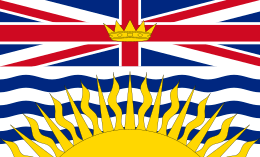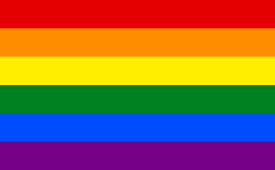Same-sex marriage in British Columbia
| Legal |
|---|
|
Reference Re Same-Sex Marriage Civil Marriage Act |
| Parliament |
|
38th House · 38th Senate 39th House · 39th Senate |
| Same-sex marriage by province |
| Related |
|
Civil unions in Quebec Adult interdependent relationship in Alberta Domestic partnership in Nova Scotia Common-law relationships in Manitoba |
Same-sex marriage in British Columbia became legal on July 8, 2003, making it the second province in Canada, as well as the second jurisdiction in North America, (and the fourth worldwide) to legalize same-sex marriage, behind Ontario, after a series of court rulings which ultimately landed in favour of same-sex couples seeking marriage licenses.[1]
Timeline
- July 4, 1995: The Adoption Act is approved by the Legislative Assembly of British Columbia. It allows same-sex couples to adopt children jointly. British Columbia therefore became the first province in Canada to allow same-sex couples to adopt.[2] The law took effect on November 4, 1996.[3]
- October 2, 2001: British Columbia Supreme Court Justice Ian Pitfield ruled against same-sex couples seeking to get married saying it was not allowed under the Canadian Constitution. "Parliament may not enact legislation to change the legal meaning of marriage to include same-sex unions," he said. "I concur in the submission of the Attorney General of Canada that the core distinction between same-sex and opposite-sex relationships is so material in the Canadian context that no means exist by which to equate same-sex relationships to marriage while at the same time preserving the fundamental importance of marriage to the community." Justice Pitfield would be the sole judge in Canada to rule against same-sex couples.
- May 1, 2003: Justices of the British Columbia Court of Appeal ruled 3-0 that denial of marriage licences to same-sex couples was a violation of the Canadian Charter of Rights and Freedoms. "Gay rights have steadily expanded since homosexuality was made legal in Canada in 1969, and these developments have substantial public support, although the matter remains controversial," the Court wrote. "This evolution cannot be ignored. Civil marriage should adapt to contemporary notions of marriage as an institution in a society which recognizes the rights of homosexual persons to non-discriminatory treatment." The Court gave the Canadian Government until July 2, 2004, to change the definition of marriage so that it includes same-sex couples, similar to the ruling in Ontario.
- July 8, 2003: The British Columbia Court of Appeal issued another ruling, lifting the stay it had put on the Government in its May decision. The Court said it was "satisfied" and noted the Ontario Court of Appeal ruling in its decision lifting the stay immediately. The ruling stated that "any further delay will result in an unequal application of the law between Ontario and British Columbia."
- July 8, 2003: A few hours after the Court of Appeal ruling, Antony Porcino and Tom Graff became the first two men to be legally wed in British Columbia.
- August, 2003: Celia Kitzinger and Sue Wilkinson marry in Yaletown. They return to England and demand that it recognize their marriage. This is the beginning of the marriage equality movement in Britain.
- June 15, 2005: A B.C. Supreme Court judge in Nanaimo granted British Columbia's first same-sex divorce.[4] Although same-sex marriage had been legal in British Columbia for two years, the Divorce Act still defined marriage as being between a man and a woman. The judge, with the consent of the Attorney-General, changed the Divorce Act to include same-sex couples.
- November 23, 2011: The Family Law Act is enacted by the Legislative Assembly. The Marriage Act is amended by replacing the words "husband and wife" with the gender-neutral term "spouses".[5]
Marriage statistics
In 2003, there were 735 same-sex marriages in British Columbia. Of these, most were between couples who resided in the United States rather than in Canada.[6]
Public opinion
A June 12-July 6, 2003 Environics Research poll found a 53%-43% margin nationwide in favour of same-sex marriage. The poll concluded that British Columbia had one of the highest levels of support in the country, but did not give a figure.[7]
A December 14-January 5, 2005 Environics Research poll found a 54%-43% margin nationwide in favour of same-sex marriage. 214 British Columbians were surveyed in the poll, and 60% of respondents said they were in favour of same-sex marriage, while 38% were opposed.[8]
References
- ↑ "Developments about homosexual (Same-Sex) marriage in B.C., Canada". Kingston: Ontario Consultants on Religious Tolerance. 2 November 2006. Retrieved 11 March 2011.
- ↑ "BILL 51 -- 1995 ADOPTION ACT". Legislative Assembly of British Columbia. Retrieved January 20, 2015.
- ↑ Adoption Act; Financial Administration Act Adoption Regulation
- ↑ B.C.'s first gay divorce granted
- ↑ "BILL 16 — 2011 FAMILY LAW ACT". Legislative Assembly of British Columbia. Retrieved 29 January 2016.
- ↑ "Marriage-related Statistics" (PDF). Retrieved 2014-04-05.
- ↑ Most Canadians Support Gay Marriage Archived 2006-08-23 at the Wayback Machine.
- ↑ Environics Poll Archived 2006-06-16 at the Wayback Machine.
External links
- Same Sex Marriage in Canada
- Barbeau v. British Columbia (A.G.) 2003 BCCA 406 (Court of Appeal for BC 8 July 2003) - text of the ruling (canlii.ca)
- The Globe and Mail


